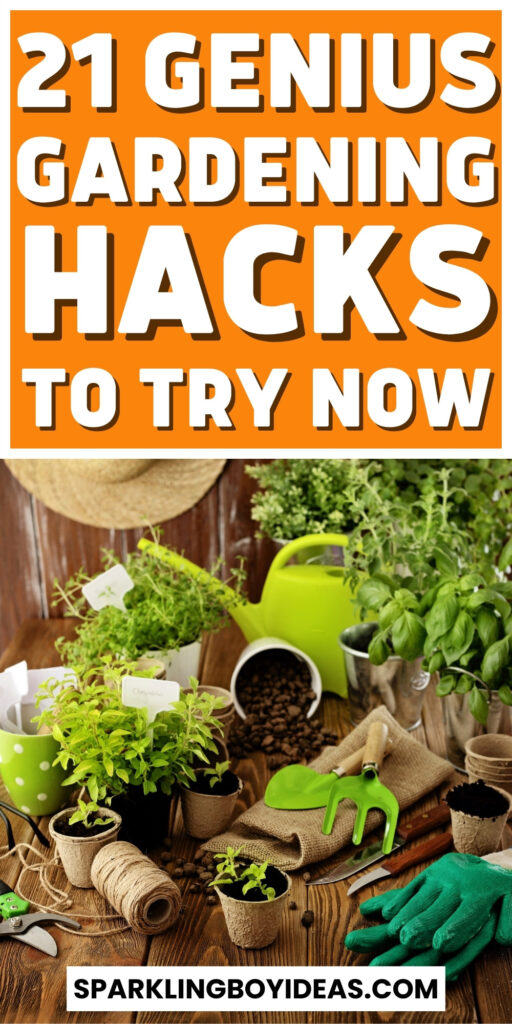Discover mind-blowing gardening hacks that will transform your backyard! Unleash your green thumb today!

As someone who loves spending time outdoors and getting my hands dirty, gardening has become a passion of mine.
But let’s be real, it can be a lot of work!
Over the years, I’ve discovered a few gardening hacks that have made my life easier and my garden more beautiful.
Whether you’re a seasoned green thumb or just starting out, these tips and tricks are sure to come in handy.
From repurposing household items to saving time and money, these gardening hacks will take your gardening game to the next level.
So grab your gloves and let’s get started!
21 Gardening Hacks For A Flourishing Garden
Gardening hacks are clever techniques and practices that can simplify gardening tasks, boost plant growth, and improve overall garden health.
These hacks are based on practical knowledge and innovative ideas that have been proven to work effectively.
By incorporating gardening hacks into your routine, you can save time, minimize effort, and maximize the results of your gardening endeavors.
These hacks offer practical solutions to common gardening problems, allowing you to create an environment where plants thrive and flourish.
Soil Preparation
1. Choosing the right soil for your garden
The foundation of a successful garden lies in its soil. It’s important to choose the right type of soil that suits the needs of your plants.
Consider factors such as drainage, fertility, and pH levels when selecting soil for different areas of your garden.
2. Testing and improving soil quality
Before planting, it’s beneficial to test the quality of your soil.
Soil testing kits are easily available and can provide valuable insights into the nutrient levels and pH balance of your soil.
Based on the results, you can amend the soil with organic matter, such as compost or peat moss, to improve its quality.
3. Mulching techniques for soil moisture retention
Mulching is a simple yet effective gardening hack that helps retain moisture in the soil, suppress weed growth, and regulate soil temperature.
Use organic materials like straw, wood chips, or leaves as mulch around your plants to conserve water and promote healthy root development.
Planting Techniques
4. Proper spacing and arrangement of plants
When planting your garden, it’s crucial to provide adequate spacing between plants.
This allows for proper air circulation, reduces the risk of diseases, and prevents overcrowding.
Follow the recommended spacing guidelines for each plant variety to ensure optimal growth and development.
5. Companion planting for pest control and nutrient enhancement
Companion planting is a technique where certain plants are grown together to maximize their benefits.
Some plants naturally repel pests, while others enhance nutrient absorption or provide shade.
For example, planting marigolds near tomatoes can deter aphids, while growing beans alongside corn enrich the soil with nitrogen.
6. Utilizing vertical gardening for maximizing space
If you have limited space, vertical gardening is an excellent hack to grow more plants in a small area.
Install trellises, and vertical planters, or use hanging baskets to take advantage of vertical space.
Vining plants like cucumbers, beans, and tomatoes can be trained to grow upwards, saving precious ground space.
Watering and Irrigation
7. Efficient watering techniques
Watering your garden properly is essential for plant health.
Instead of shallow and frequent watering, opt for deep watering sessions that penetrate the root zone.
This encourages plants to develop deep and strong root systems.
Water early in the morning to reduce evaporation and minimize fungal diseases.
8. Drip irrigation systems for water conservation
Drip irrigation is a water-efficient method that delivers water directly to the plant’s root zone.
It minimizes water waste and reduces the risk of overwatering or underwatering.
Install a drip irrigation system in your garden, or use drip irrigation stakes or soaker hoses for targeted watering.
9. Rainwater harvesting methods
Take advantage of nature’s gift by collecting rainwater for your garden.
Set up rain barrels or a rainwater harvesting system to capture and store rainwater.
Use this collected water for watering your plants, reducing your reliance on tap water, and conserving water resources.
Fertilization and Nutrient Management
10. Organic fertilizers for healthier plants
Opt for organic fertilizers that nourish your plants while being environmentally friendly.
Organic options such as compost, well-rotted manure, and worm castings provide a slow release of nutrients and improve soil structure.
They promote beneficial microbial activity, leading to healthier and more resilient plants.
11. Composting for sustainable nutrient supply
Start a compost pile or bin to recycle kitchen scraps, yard waste, and plant trimmings.
Compost is a nutrient-rich amendment that enhances soil fertility and structure.
Incorporate compost into your garden beds regularly to provide a steady supply of organic matter and essential nutrients to your plants.
12. Foliar feeding to boost plant growth
Foliar feeding is a technique where liquid fertilizer is sprayed onto the leaves of plants.
This allows for direct nutrient absorption, bypassing the root system.
Use a balanced liquid fertilizer and spray it on the foliage during the early morning or late afternoon.
This method can provide a quick nutrient boost to plants experiencing deficiencies.
Pest and Weed Control
13. Natural pest control methods
Combat garden pests without resorting to harsh chemicals.
Encourage beneficial insects like ladybugs and lacewings by planting flowers that attract them, such as daisies or alyssum.
Use organic pest repellents like neem oil, garlic spray, or insecticidal soap to deter common garden pests.
14. Weed prevention and management
Prevent weeds from taking over your garden by applying a layer of mulch.
This suppresses weed growth and conserves soil moisture.
Regularly inspect your garden and manually remove weeds before they have a chance to spread their seeds.
For stubborn weeds, use a handheld weeding tool or carefully apply an organic weed killer directly to the weed, taking care to avoid nearby plants.
15. Companion planting for pest deterrence
Certain plants have natural properties that repel pests.
Incorporate them strategically throughout your garden to create a pest-resistant environment.
For example, planting aromatic herbs like basil, rosemary, or lavender near susceptible plants can deter pests like aphids or mosquitoes.
Pruning and Plant Maintenance
16. Proper pruning techniques for plant health
Pruning is an essential gardening practice that promotes healthy growth and maintains plant shape.
Learn proper pruning techniques for different plants, such as removing dead or diseased branches, shaping shrubs, or encouraging fruit production.
Regular pruning improves airflow and reduces the risk of fungal infections.
17. Deadheading and pinching to promote flower production
Deadheading is the process of removing spent flowers from plants.
This encourages the production of new blooms and prolongs the flowering season.
Pinching involves gently removing the tips of young plant shoots to promote bushier growth and more compact plants.
18. Staking and supporting plants for better growth
Some plants, such as tomatoes or tall flowers, benefit from staking or support structures.
Properly stake plants to prevent them from bending or breaking under their weight.
Use bamboo stakes, trellises, or cages to support plants, ensuring they grow upright and receive adequate sunlight and airflow.
Seasonal Gardening Hacks
19. Winterizing your garden
Prepare your garden for the winter months by taking the necessary precautions.
Mulch around the base of perennial plants to insulate their roots and protect them from freezing temperatures.
Remove annual plants and vegetables that are no longer productive and clean up debris to prevent overwintering pests and diseases.
20. Protecting plants from frost and extreme temperatures
Cover delicate plants with frost blankets or cloths during frosty nights to shield them from freezing temperatures.
Use cold frames or mini-greenhouses to provide a protected environment for sensitive plants.
Water plants thoroughly before a cold spell to help insulate their roots.
21. Extending the growing season with greenhouses or cold frames
Invest in a greenhouse or construct a cold frame to extend your growing season.
These structures create a controlled environment that allows you to start seeds early or grow tender plants that wouldn’t thrive in your region’s climate.
Monitor temperature and ventilation to provide optimal growing conditions.
FAQs
Q. How often should I water my garden?
The frequency of watering depends on various factors such as the type of plants, soil moisture levels, and weather conditions. As a general rule, it’s better to water deeply and less frequently to encourage deep-root growth. Monitor the soil moisture and water when the top inch of the soil feels dry.
Q. Can I use coffee grounds as a natural fertilizer?
Yes, coffee grounds can be used as a natural fertilizer. They are rich in nitrogen and can enhance soil fertility. However, it’s important to use them in moderation and mix them with compost or soil to prevent nitrogen burn or acidity buildup.
Q. What are some companion plants for tomatoes?
Some beneficial companion plants for tomatoes include basil, marigolds, borage, and carrots. Basil improves the flavor of tomatoes and repels pests, while marigolds deter nematodes. Borage attracts pollinators, and carrots can interact positively with tomatoes by improving the soil structure.
Q. How do I prevent weeds from taking over my garden?
To prevent weeds, start by ensuring your garden beds are properly mulched. Apply a layer of organic mulch like straw, wood chips, or leaves to suppress weed growth and conserve moisture. Regularly inspect your garden and manually remove weeds as soon as they appear, before they have a chance to spread.
Q. When is the best time to prune roses?
The ideal time to prune roses depends on the specific type and your climate. However, a general rule is to prune roses in late winter or early spring when they are still dormant. This helps stimulate new growth and promotes healthy flowering during the growing season. Consult specific pruning guidelines for different rose varieties.


Conclusion
By implementing these 21 gardening hacks, you can significantly enhance the health and productivity of your garden.
From soil preparation to seasonal maintenance, each hack serves a purpose in creating a flourishing garden.
Experiment with these techniques, adapt them to your specific needs and enjoy the rewards of a vibrant and thriving garden.









